When you find yourself with extra peaches, plums, apricots, nectarines, and/or cherries on hand ... make some stone fruit wine! Here's how.

Stone fruit season is upon us, so I figure it’s about time I finally share my recipe for making stone fruit wine!
This wine is a great way to use up stone fruit.
Here in Hamilton, the farmer’s markets are full of stands with cases of beautiful local peaches, plums, apricots, and cherries... and it’s super easy to over-purchase!
The nice thing about this recipe is that it’s super customizable.
Where most of our recipes are for a single fruit - or more than one, but in certain quantities - this recipe is definitely more freeform.
You can use whatever mix of stone fruits that you like, in whatever proportions we like.
A bunch of peach and a bit of cherry? Awesome.
Everything? Great!
Just cherries and plums? Beauty.
We used peaches, plums, and cherries, but apricots, nectarines, etc are all great possibilities as well.
When we originally put this recipe together, we went with whatever we had left over after a trip to the farmer’s market - We used 2 lbs plums, 1 lb each cherries and peaches.
It turned out a beautiful fruit-punch coloured wine, bursting with complex flavour!
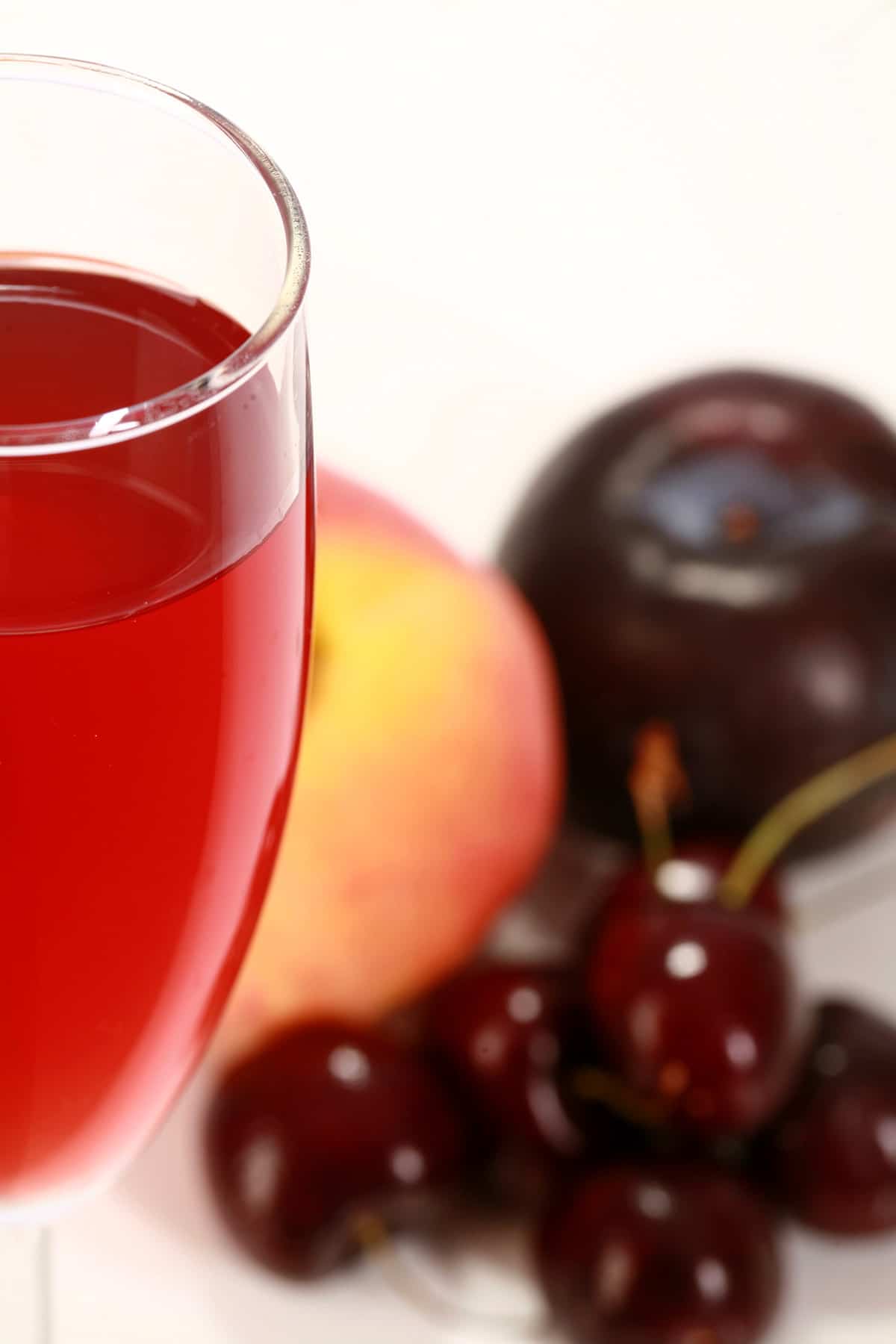
How to Make Stone Fruit Wine
If you haven't attempted making wine before, don't be intimidated! Check out our primer to home brewing:
- Wine Making At Home, Part 1: Why?
- Wine Making at Home, Part 2: Equipment to Get Started
- Wine Making at Home, Part 3: The Brewing Process.
- Wine Making at Home, Part 4: How to Stabilize and Back Sweeten Wine
Just a small handful of entries, and you'll be good to go!
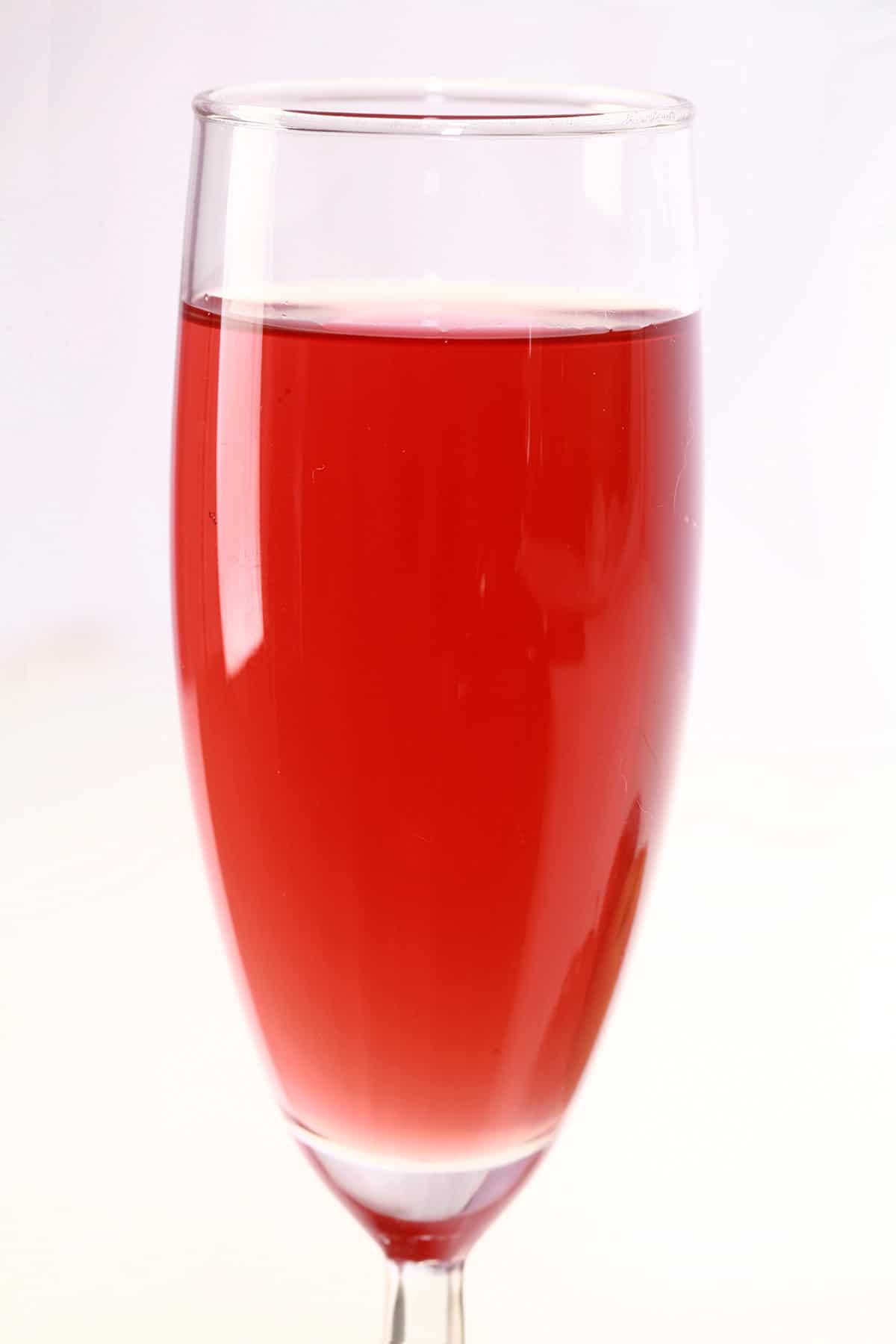
Stone Wine Ingredients
This wine recipe requires only a few ingredients to make - super simple! Here is some information about those base ingredients that you may find helpful.
Fruit
You can use fresh or frozen stone fruit - or a combination! - to make this wine. There are just a few differences in how to use them, and things to keep in mind:
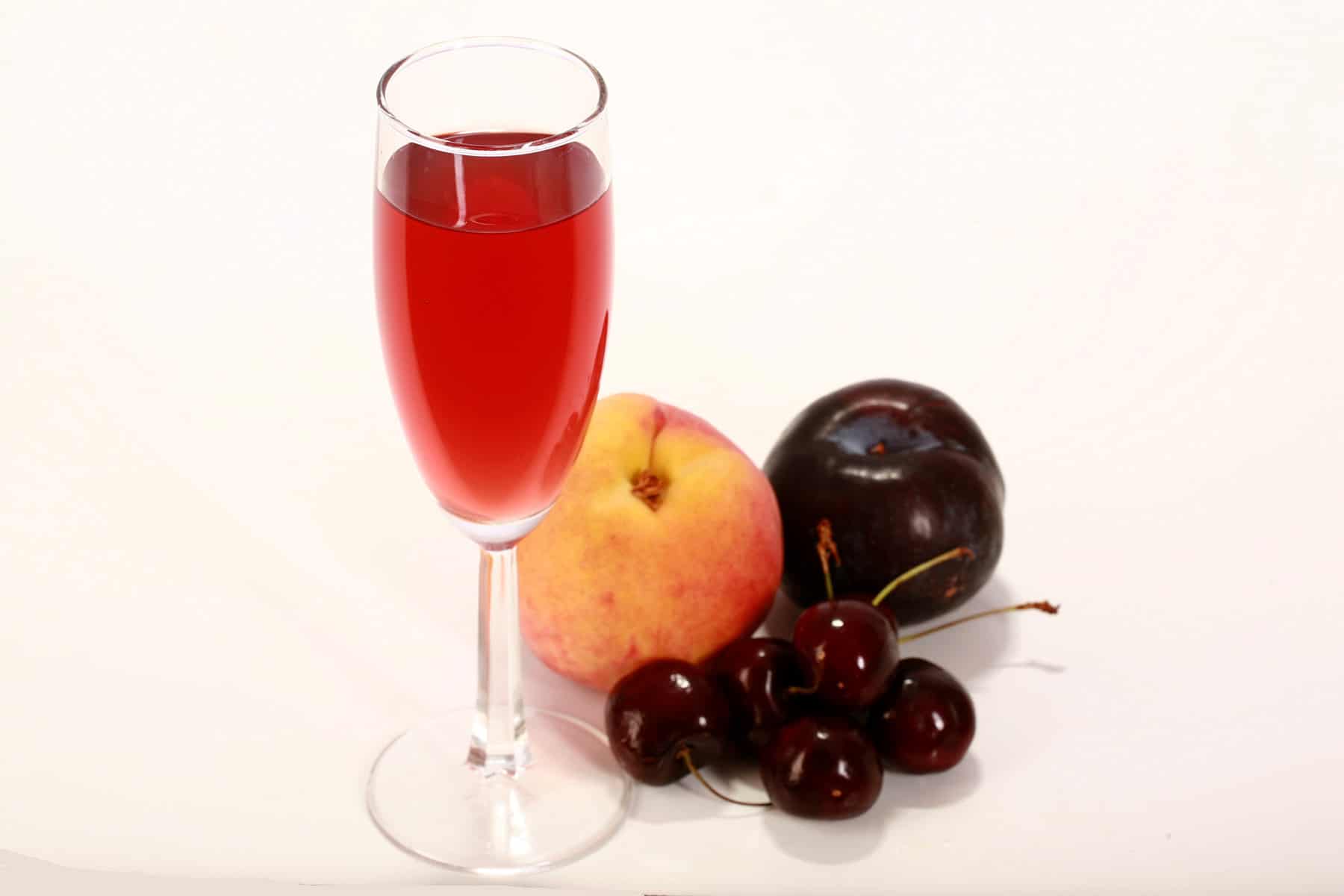
Fresh Stone Fruit
When using fresh fruit, be sure to use very ripe, flavourful fruit only. Ideally, use something in-season, as off season fruit never seems to taste as good!
I like to macerate the fruit for several hours before I start making the wine.
By that, I mean I’ll pit and chop up the stone fruit and put them in a large bowl or pot, and stir in the sugar.
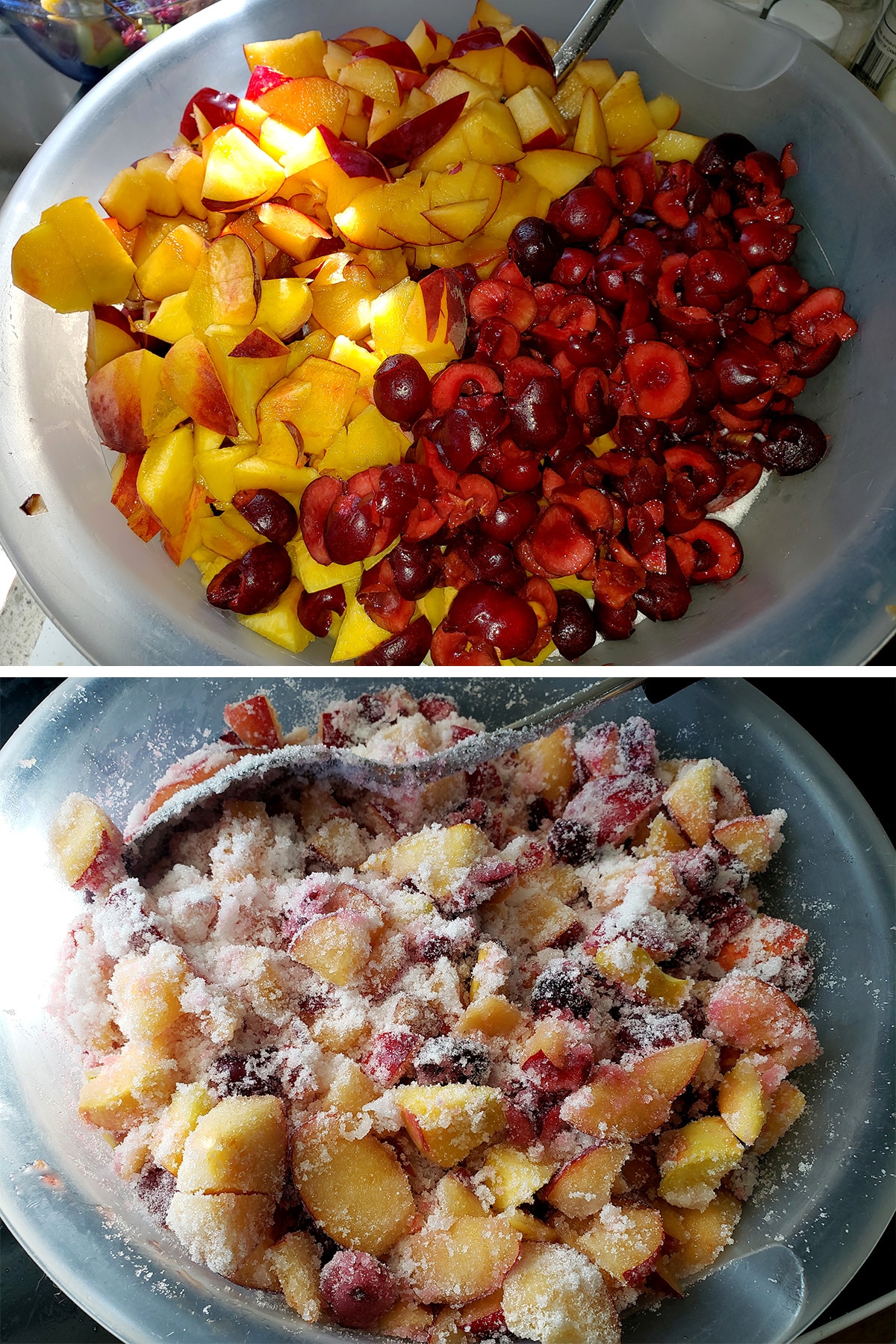
Then, I cover and leave it for a while, to let the sugar do its thing.

The sugar draws the natural juices - and flavour! - out from the fruit. I find this gives the best base to the wine, rather than starting with chopped fruit and water.
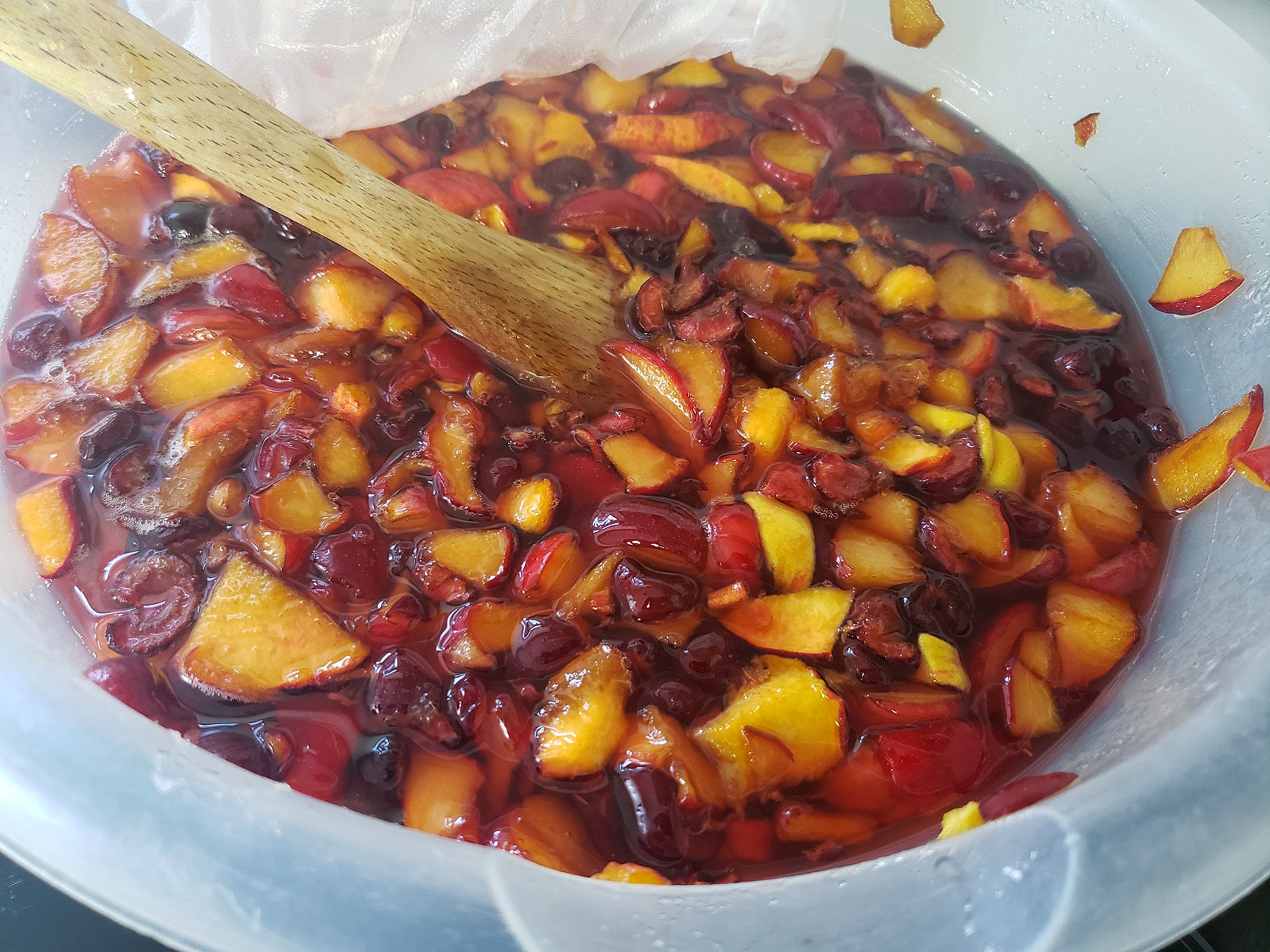
Frozen Fruit
When using frozen fruit, you can skip the maceration process. Freezing and thawing stone fruit - or pretty much any fruit - breaks them down in a way that ends up with a result similar to maceration.
Be sure to use a good brand of frozen fruit, and that the fruit is good and flavourful when they thaw. If your fruit doesn’t have much flavour, neither will your wine.
Sugar
While sugar is technically optional when making wine, NOT adding any sugar will result in an INCREDIBLY dry wine.
When you’re making wine from stone fruit - much like with any other light coloured, non-grape fruit - you’ll want it to have at least some residual sweetness to it, or it just won’t taste like much. The sugar helps to bring out the fruit flavour!
Sugar is an important part of winemaking, and there are a few aspects of sugar to keep in mind:

Type of Sugar
In terms of type of sugar, we prefer to use plain white granulated sugar for this wine. Sometimes we’ll use brown sugar for part of the sugar content to give it a bit of a deeper flavour - more like a fruit cobbler flavour - but generally stick to white sugar.
Feel free to use either type, raw cane sugar, or a mixture of any/all of these.
Note: If you’re going for the brown sugar for some or all of the sugar, try adding a vanilla bean and a cinnamon stick to your boiled mixture, leaving them in through fermentation!)
How to Make Stone Fruit Mead
If you’d like to make a mead rather than a wine, you can swap the sugar out for honey. We’ll usually use 4-5 lbs of honey for this.
A couple of notes:
- I say “Stone Fruit Mead”, as that’s what most people would understand... but mead with fruit is technically called “melomel”.
So, swapping sugar out in favour of honey would give you a stone fruit melomel. The more you know!
- When you’re using honey instead of sugar, you’re going to want to be careful in your choice of honey. Where white sugar is fairly neutral in flavour, honey can be aggressively flavoured.
I recommend picking something lightly coloured and lightly flavoured - a clover or orange blossom honey, for instance.
Something like a wildflower or buckwheat honey is likely to completely overwhelm the flavour from the stone fruit.

Alcohol Content
Aside from flavour, there’s the matter of alcohol content.
Your wine’s final ABV will vary wildly dependent on a few things: The initial sugar content of the fruit you use, how much sugar you add, and what kind of yeast you use (more on that in a bit)
Any amount of sugar will result in a higher alcohol content than making the same wine without sugar added.
Sugar - both in the base fruit itself, and from the added sugars - is what feeds the yeast, the yeast eats up the sugars and gives off alcohol as the byproduct of that process.
More sugar = more food = more alcohol... to a point, anyway. About that...
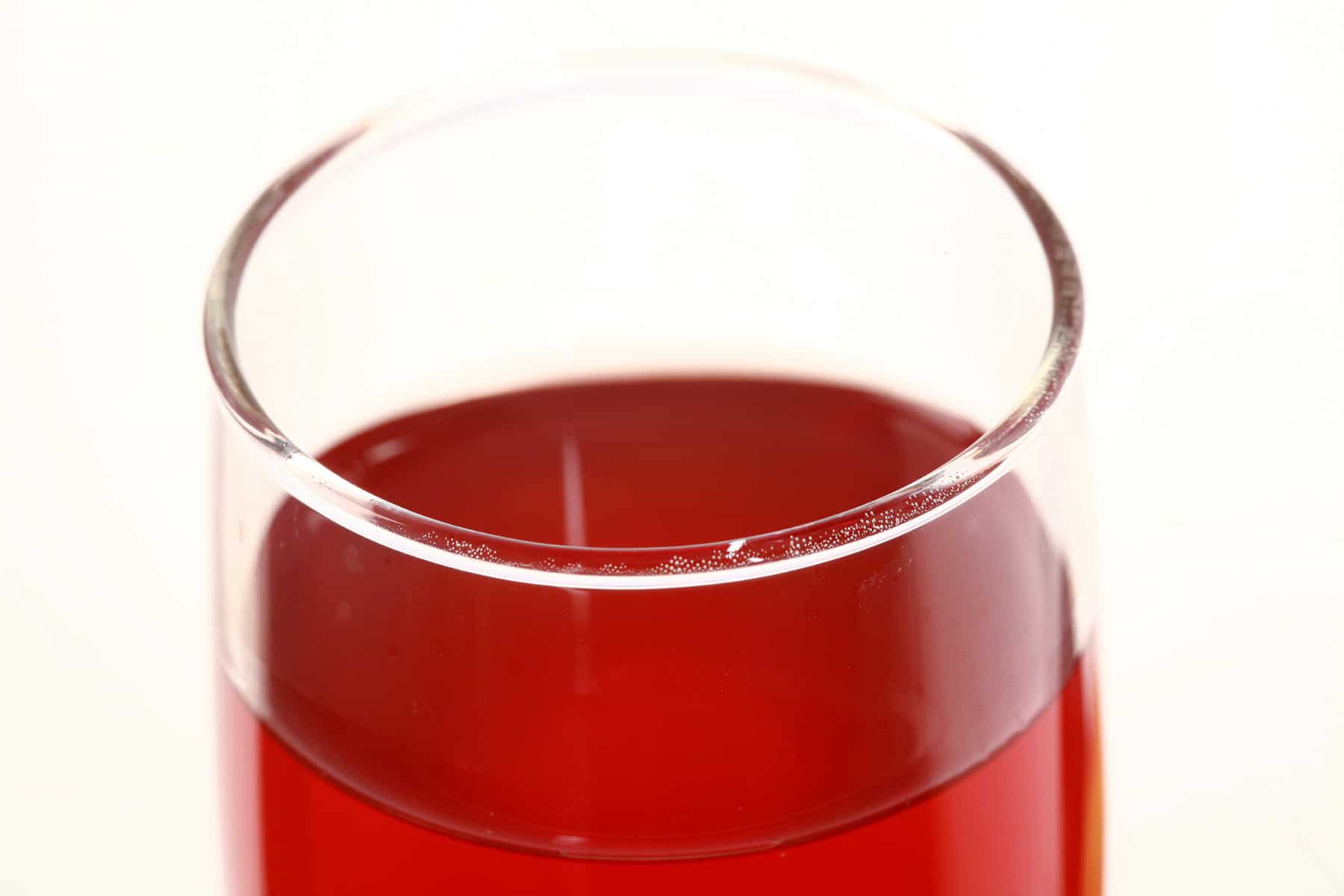
Yeast
The type of yeast you use will impact the alcohol content of the final product.
Yeast organisms don’t have an *unlimited* capacity to process sugar into alcohol. At some point, the environment they’re living in - the brewing wine - becomes too high in alcohol for the yeast to survive. They die off, the fermentation stops.
Different types of yeast have different tolerances for alcohol in the environment. That is, some yeast will be able to survive higher amounts of alcohol in the wine, so they’ll continue producing it longer than some other types.
Some types of yeast will bring you to something like an 8% ABV, while others will let things run wild until close to 20% ABV.
It’s good to know what you have in mind, when you choose your yeast.
Ask your local homebrew supply shop for recommendations based on what you’re looking for.
If you want a sweet wine with a low-ish ABV - without having to back sweeten it (more on that in a bit) - choose a yeast with a lower tolerance for alcohol.
If you’re looking for a dry wine with a low ABV, choose a yeast with a lower tolerance for alcohol, and don’t use a ton of sugar.
If you want a sweet wine with a high ABV, use a bunch of sugar with a high-tolerance yeast... and be prepared to backsweeten it.
If you want a dry wine with a high ABV, use a fair amount of sugar and a high tolerance yeast.

Everything Else
Everything else in this recipe is technically optional, but contributes to it finishing as a well balanced wine. These ingredients include:
Acid Blend, Tannin - Balances and rounds out the flavours.
Pectic Enzyme - Breaks down fruit, especially as it relates to preventing “haze” from the pectins.
Yeast Nutrient - Gives a boost to the yeast.
Making Larger Batches of Wine
As a note, you can easily scale this wine recipe up - in fact, there's a function inside the recipe card itself to do the math for you!
One note, though: You don't need to multiply the yeast, but the software doesn't know that. We will use one pouch of yeast for anything from 1-5x batches, and then 1 pouch for every 5x batches beyond that.
As a related note: The recipe software is definitely geared towards cooking, not wine making. Therefore, you can pretty much ignore all of the info it gives you: The nutritional info is calculated on everything that goes into the wine.
It does not take into account how much sugar will be fermented out, how much volume is lost to racking, the fact that the fruit pulp is removed before the final product, etc.
Back Sweetening Your Homemade Stone Fruit Wine
Sometimes - usually, even - you’ll find that the yeast went a bit too far with their smorgasbord, and you end up with a stone fruit wine that’s not as sweet as you’d like it.
... and that’s when you back sweeten it! You can read my How to Stabilize and Back Sweeten Wine post for information on how to back sweeten it.
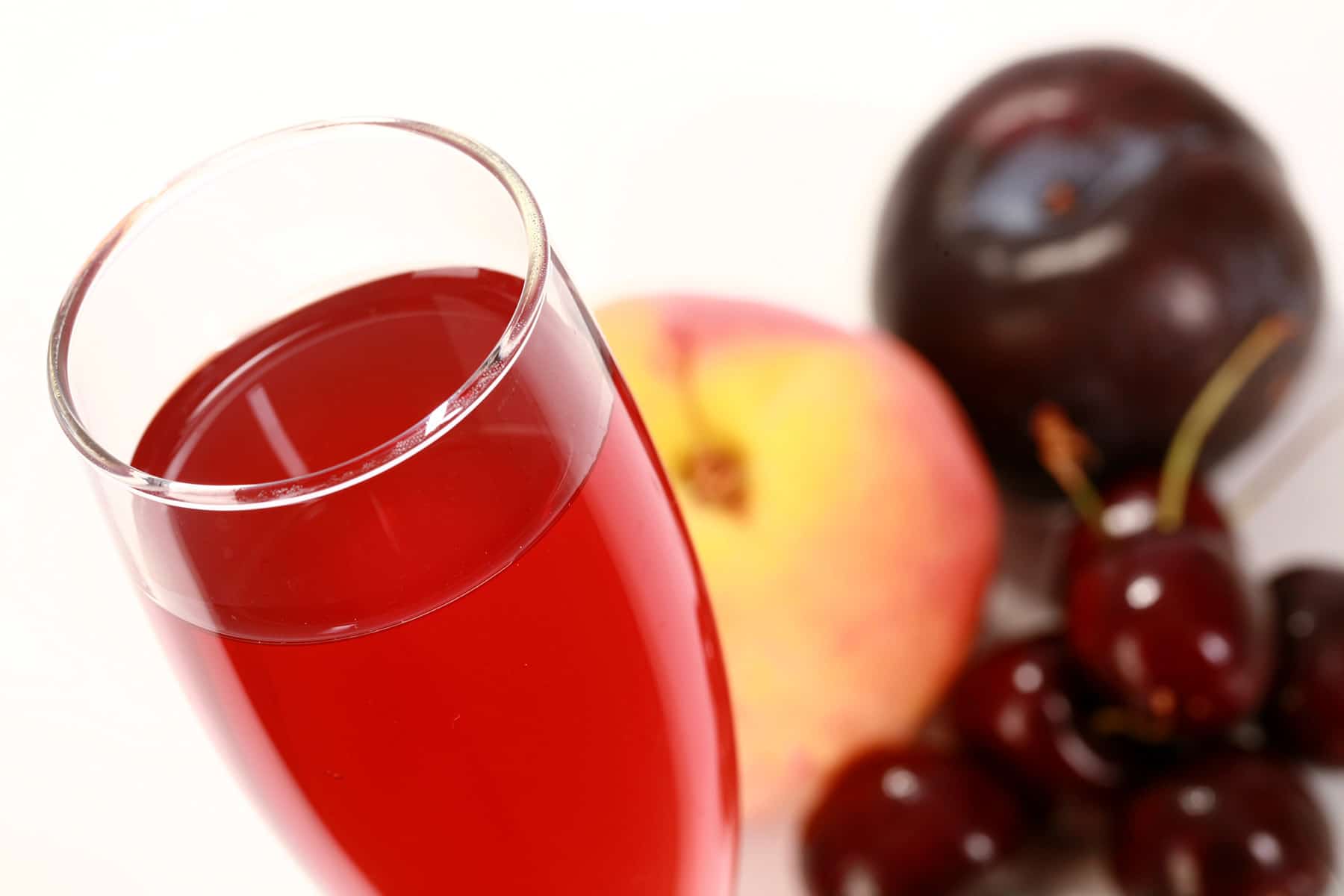
How to Make Sparkling Stone Fruit Wine
Stone fruit wine is especially nice as a bubbly beverage. There are two main ways to accomplish this, both of which happen AFTER fermentation has ceased.
Note: Consult your local homebrew store for what your options are when it comes to bottling sparkling wine. As this ferments a bit in the bottle, normal wine bottles aren’t a good idea - they can explode from the extra pressure.
We’ll usually use beer bottle and caps for any sparkling wine or sparkling ciders that we make, but there are options more along the lines of champagne bottles. Selection and brands tend to vary wildly by location.
Anyway!
For Naturally Carbonated Sparkling Stone Fruit Wine
In a small pot, mix together 1 cup of water with 1 cup of sugar or brown sugar - whichever you used in the wine.
Use a sanitized funnel to pour this into a sanitized large carboy.
Rack the wine over into this carboy, swirling it as you go.
Bottle the wine into appropriate bottles, following directions for whatever kind of cap/closure you will be using.
Allow wine to age at least a month or two – residual yeast will ferment the added sugar, carbonating the wine. Serve chilled.
For Force-Carbonated Sparkling Wine
Alternatively, you can rack the wine (without the added sugar syrup!) into a keg and force carbonate it, if you have the set up for that - That’s what we tend to do with our ciders.

More Home Brewing Recipes!
While you've got your current homebrew fermenting away, why not consider putting a batch of something else on, to occupy your wait time? Here are a few of my other wine, cider, and mead recipes:
Wine Recipes
Banana Wine Recipe
Blackberry Wine Recipe
Blackcurrant Wine Recipe
Blueberry Wine Recipe
Cherry Wine Recipe
Cranberry Clementine Christmas Wine Recipe
Cranberry Wine Recipe
Faux Lingonberry Wine
Lychee Wine Recipe
Mango Strawberry Wine Recipe
Mango Wine Recipe
Mint Wine Recipe
Lychee Wine Recipe
Partridgeberry Wine Recipe
Passionfruit Wine Recipe
Peach Wine Recipe
Strawberry Wine Recipe
Ube Wine Recipe
Watermelon Wine Recipe
Mead Recipes
Black Cherry Mead Recipe
Blueberry-Clementine Mead Recipe
Blueberry Mead Recipe
Clementine Mead Recipe
Pumpkin Mead Recipe
Wildflower Mead Recipe
Cider & Miscellaneous Homebrew Recipes
Hard Apple Cider Recipe
Home Brew Hard Iced Tea Recipe
Maple Hard Apple Cider Recipe

Share the Love!
Before you drink up, be sure to take some pics of your handiwork! If you post it to Bluesky, be sure to tag us - @CelebrationGen. We're also on Pinterest, so you can save all your favourite recipes to a board!
Also, be sure to subscribe to my free monthly email newsletter, so you never miss out on any of my nonsense.
Well, the published nonsense, anyway!
Homemade Stone Fruit Wine
Equipment
- Large pot
- Slotted Spoon
- 2 gallon fermenter bucket and lid
- 1 air lock and stopper
- Long spoon / paddle
- 2 1 gallon carboys
- Siphon, siphon tubing.
Ingredients
- 4 Lbs mixed fresh stone fruit: Peaches plums, nectarines, cherries, apricots
- 6 cups Granulated Sugar
- 1 gallon Spring Water
- 1 cup Golden Raisins
- 1 teaspoon Acid Blend
- 1 teaspoon Yeast Nutrient
- ½ teaspoon Pectinase / Pectic enzyme
- Yeast
Instructions
- Wash fruit. Pit everything and chop into small chunks.
- Add fruit to a large pot. Add sugar, stir well. Cover and let it sit for a few hours, stirring every once in a while.
- After about 2-3 hours, the sugar should have nicely macerated the fruit. Add As much of the water as your pot can handle, bring ALMOST to a boil.
- Once water starts bubbling, turn the temp to low and simmer for 1 hour. Think more “keep it warm”, than any kind of active simmer. You want to kill off any wild yeast, not make jam!
- While the pot is simmering, prepare your fermenter bucket:
- Wash and sanitize a 2 gallon plastic fermenter, lid, stopper, and air lock.
- Place raisins, acid blend, yeast nutrient, and pectic enzyme into the plastic fermenter.
- Affix the stopper to the lid of the fermenter, cover and set aside.
- Once the hour is up, remove from heat, allow to cool. It doesn’t have to be all the way to room temperature, just cool enough that if it splashes on you, it won’t hurt - that’s a good guideline!
- Carefully pour stone fruit and water into the fermenter. Top up with any remaining water.
- Affix air lock to lid, cover the bucket, and allow to fully cool over night. For the sake of consistency in readings - and therefore accuracy in ABV calculations - this should be done where you plan to let the wine ferment for the next few months - usually a basement.
- The next morning, check the Specific Gravity and write it down in your notes, along with the date.
- Add yeast to the fermenter bucket, stir with a long, sanitized spoon. Affix the lid, allow to sit for 24 hours.
- The next day, check to make sure that the yeast has started fermenting - there should be bubbles in the airlock, and/or foam in the liquid.
- Put the lid back on, allow to ferment for one week.
- After a week or so, use your sanitized siphon setup to rack the must into a freshly sanitized carboy. Put the carboy somewhere cool (not cold!), and leave it alone for a month or so.
- Using sanitized equipment, rack the stone fruit wine off the sediment, into a clean, freshly sanitized carboy. Cap with sanitized airlock, leave it alone for another 1 month.
- Rack one more time, leave it for another 2 months or so.
- When your wine has been racked a few times and shows NO more fermenting activity for a month or so (no bubbles in the airlock, no more sediment being produced, you can move on to bottling.
- Follow the instructions on your selected type of wine stabilizer to stop fermentation from restarting. For potassium sorbate, this needs to be done 2-3 days before bottling.
- Using sanitized equipment, take a gravity reading if applicable, then back sweeten as desired, using sanitized equipment.
- Using sanitized equipment, rack the wine into clean, sanitized bottles. Cork.







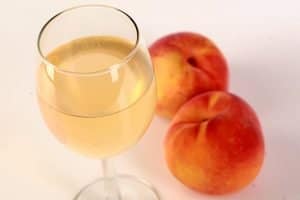

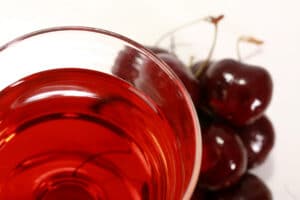
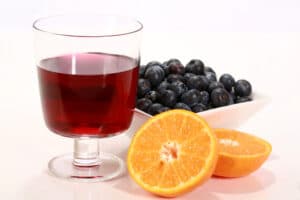
Leave a Reply